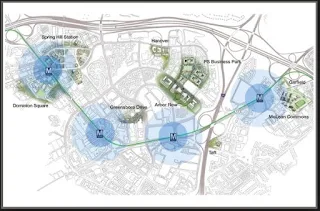Transit-oriented development projects should, at the very least, encourage the use of public transit by siting residential, commercial, or office uses – or a combination of all three – close to a transit node. However, successful TOD involves more than simply placing a transit stop in a residential neighbourhood or business park, or building a mixed use TOD development next to a transit hub.
What is Transit Oriented Development?
Transit Oriented Development refers to residential and commercial Centres designed to maximize access by transit and non-motorized transportation, and with other features to encourage Transit Ridership. A typical TOD has a rail or bus station at its centre, surrounded by relatively high-density development, with progressively lower-density spreading outwards one-quarter to one-half mile, which represents pedestrian scale distances. It includes these design features.A transit-oriented development (TOD) is any development that induces people to prefer the use of public transit. It is compact, mixed use development near new or existing public transportation infrastructure that provides housing, entertainment and civic functions within walking distance of transit. A TOD neighbourhood typically has a centre with a transit station or stop (train metro, metro station, bus stop etc.), surrounded by relatively high-density development with progressively lower-density development spreading outwards from the centre.
IMPORTANCE OF TRANSIT ORIENTED DEVELOPMENT
Urbanization, sprawl and economic growth have resulted in the increased number of private vehicles. This increase is so as to have ease in commuting to different places that in turn leads to congestion. If planning is done in such a way that development takes place about any public transit area, then this can help in reducing traffic congestion and increasing the use of public transport. This is what transit oriented development is all about. But everything has certain positive and negative effects. Thus it is necessary to analyze the opportunities and constraints related with this development.
BRIEF HISTORY OF TRANSIT-ORIENTED DEVELOPMENT
The first transit-oriented development projects in the United States were the railroad and streetcar suburbs of the late 19th and early 20th centuries. The earliest commuter rail lines were powered by steam engines that could achieve high sustained speeds efficiently but were slow to accelerate and decelerate, and thus promoted the development of stations that were several miles apart. In New York City, for example, three commuter railroads – the Hudson River Railroad, Harlem River Valley Railroad, and Long Island Sound Railroad – helped channel population expansion from the five boroughs to outlying suburban townships. Although more common in large east coast cities, a steam-powered commuter rail service did exist in the San Francisco Bay Area in the late 19th century. The San Francisco-San Jose railway began service along the Peninsula in 1864, and led to the development of commuter suburbs such as Burlingame, Redwood City, and San Mateo.
Today CalTrain follows this corridor. Electric street railways were developed in the late 1880s. Electric streetcars picked up their power from an overhead electrical line, and used the running rail as a ground.
Although electric streetcars could not achieve the top speeds of the steam engines, they were cleaner, quieter, and could start and stop more efficiently, making them useful for interurban as well as commuter service. Construction of electric railway systems was typically privately funded, as developers built rail lines to outlying areas and used the railways to promote their real estate holdings. The first electric streetcar system was the Pacific Electric Railway in southern California which, at its peak, served 50 communities with 1,164 miles of track and 270 trains a day.
In the San Francisco Bay Area, the San Francisco, Oakland & San Jose Railway, more commonly known as the “Key System,” had developed a vast network of lines in the East Bay by the turn of the century. The extension of Key System lines into previously undeveloped areas of the Berkeley-Oakland Hills led to the rapid settlement of new townships such as Piedmont. By the early 1900s, electric streetcar systems had emerged in cities throughout the United States, replacing horse-drawn or cable pulled systems
Population growth followed increasing number of cars, as middle class households sought to escape crowded, dirty, and noisy inner-city living. The success of the early streetcar suburbs was dependent on pedestrian access to transit for connection to downtown jobs and neighbourhood services. Typical features of these early transit neighbourhoods included a transit depot and public space in the centre of the neighbourhood, small cottage-type houses, and a street pattern and scale that allowed convenient walking distances to transit.
CHARACTERISTICS OF TRANSIT-ORIENTED DEVELOPMENT
In addition to providing transportation options, transit-oriented development should improve the livability of communities and neighbourhoods, while successfully being integrated into the economic pattern of the area. TOD can create places for community life, serve as a key force in the revitalization of neighbourhoods and centre cities, help create new businesses and improve access to job opportunities, and help make communities safer, in part by making them more comfortable and attractive.
According to Bernick and Cervero, the hallmarks of transit-oriented development are:
- enhanced mobility and environment;
- pedestrian friendliness;
- alternative suburban living and working environments;
- neighborhood revitalization;
- public safety
- and public celebration.
Shashikant Nishant Sharma
References:
- Michael Bernick and Robert Cervero, Tr ansit Villages in the 21st Century, New York, McGraw-Hill, 1997.
- Jackson, K. T. Crabgrass Frontier: The Suburbanization of the United States. New York: Oxford University Press, 1985.
- Pickrell, D.H., Urban Rail Transit Projects: Forecast versus Actual Ridership Costs, Cambridge, Mass.: Transportation Systems Center, U.S. Department of Transportation, 1989.










